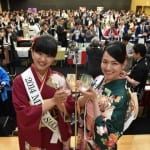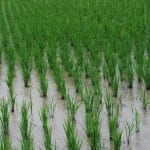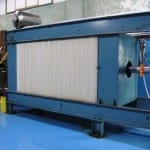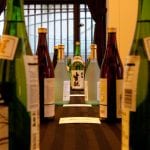 Each year, the month of April is chock full o’ sake tastings, both industry-focused and consumer-oriented. Usually these are run by distributors with dozens of brewers that each have a range of products to taste and about which to ask questions. Sometimes there are two in one day; and one can easily taste hundreds of sake in that eight hour period. It is exhausting, but important.
Each year, the month of April is chock full o’ sake tastings, both industry-focused and consumer-oriented. Usually these are run by distributors with dozens of brewers that each have a range of products to taste and about which to ask questions. Sometimes there are two in one day; and one can easily taste hundreds of sake in that eight hour period. It is exhausting, but important.
Far more important to me than actually tasting all those sake is interacting with the representatives from the kura, be they brewing personnel, or company directors. The information exchange is invaluable. Via such discussions, we can learn how this year’s rice is behaving, how the weather affected that, what new rice or yeast did they start or stop using, and what else affected how this year’s sake will turn out. Then, we can taste and confirm all that.
Groups and gangs of sake promotions notwithstanding, one of the tastings I look forward to each year is held by one brewer only, Hirako Shuzo of Miyagi Prefecture, the brewers of Hitakami sake, and run by the president Takahiro Hirai. I enjoy this particular tasting so much since Hirai-san, with whom I have been friends for a long, long time, likes to talk. He prepares a short presentation on much that transpired over the last year, and about the sake we are about to taste. And it is always educational.
The tasting itself is primarily for retailers and restaurant staff, and is held in a small, simple room in the building of his Tokyo distributor, in a drab but old and classic Tokyo neighborhood. Large bottles of this year’s brew are lined up on long, narrow tables, flanked with spittoons every meter or two.
Each bottle is labeled with the number of the tank from whence it came. The handout received upon entering gives us the necessary information: “Tank #37, Junmai-shu, Hitomebore rice milled to 60%, Miyagi Yeast, Nama Genshu, Nihonshudo 5, Acidity, 1.5”, and maybe a comment or two on what might be special. And so on down the line. Furthermore, we were given the date on which the sake was pressed, i.e. the day fermentation ended.
 As we taste, every hour or so he sits everyone down and explains a handful of things. Hirai-san has a knack for saying interesting things to a fairly educated audience, and he did not disappoint this year. Admittedly, he goes a bit deeper than even the average sake geek might be interested. But hey.
As we taste, every hour or so he sits everyone down and explains a handful of things. Hirai-san has a knack for saying interesting things to a fairly educated audience, and he did not disappoint this year. Admittedly, he goes a bit deeper than even the average sake geek might be interested. But hey.
The summer was a comparatively cold one, or at least not so hot. This means that the rice ends up softer, which in turn means it dissolves more quickly than hard rice. If the rice does not dissolve well, the sake will be short on flavor and richness. But the other side of the coin is that soft rice can dissolve too quickly and uncontrollably, and that leads to sloppy, cloying and rough flavors. So, in short, an expectation of soft rice makes brewers nervous. And that effects how they process the rice.
In particular, it affects how they soak the rice before steaming. If rice is expected to dissolve quickly, this can be countered by limiting the amount of water it is permitted to absorb. This will slow down the speed of dissolution.
To make matters even more challenging, when the weather is cold like it was this past summer, there is a lack of uniformity in the rice in terms of how fast it absorbs water. So some grains absorb too quickly, others just right, and others not at all. This makes it hard for brewers to control how it dissolves during the month-odd fermentation, since some grains have absorbed more water than others due to that lack of uniformity.Hirai-san explained their countermeasures.
“In short, we were cautious; in fact, we erred on the side of caution. So we did not let the rice absorb enough water, and the sake flavors were too tight, and not quite rich enough. And, so, we countered that in turn by letting the sake sit longer before pasteurizing it. In so doing, enzymes remaining from the koji convert left-over starch molecules to sugar; furthermore, the flavor gets richer and more umami laden in general.”
Enzymes are deactivated by heat, so as long as they do not pasteurize the sake, the enzymes will still do their job – however, they only function in a narrow temperature range. So too cold and they do not work, but too hot and they are deactivated forever.
 “The tricky part,” continues Hirai-san, “was that once we measured and tasted and knew the flavor was where we wanted it, we needed to get the enzymes to cease and desist. The problem is, we have a ton of sake that needs to be pasteurized more or less all at once. We simply cannot pasteurize fast enough in those situations; but the sake does not care! It will keep on changin’.
“The tricky part,” continues Hirai-san, “was that once we measured and tasted and knew the flavor was where we wanted it, we needed to get the enzymes to cease and desist. The problem is, we have a ton of sake that needs to be pasteurized more or less all at once. We simply cannot pasteurize fast enough in those situations; but the sake does not care! It will keep on changin’.
“So the way to do that is to lower the temperature to the point where the enzymes simply do nothing. As recently as 25 years ago, this would not have been practical. But now, we can control that pretty precisely. Modern-day refrigerated tanks make that possible,” he wrapped up.
A week later, I ran into him at another tasting, where he was one of perhaps 30 other kuramoto present that day. We returned briefly to our conversation above, what which point he warned me, “amongst these sake here today, this year you will find extremes. Some will be rough-n-tumble, others too narrow and rigid. Either too much flavor or not enough. This belies the year’s rice, its lack of uniformity, and the reticence it fosters in the brewing staff!”
What this all illustrates so well is the complexity of the sake brewing process, how important the post-fermentation steps are, and just how much one can learn with a few pre-sipping questions.
~~~~~~~~~~~~~~~~~~~~~~~~~~~~~~~~~~~~~~~~~~~~~~~~~~~~~~~~~~~~~~~~~~~~~~~~~~~~~~~~~~~~~~~~~~~~~~~~~~~~~~~~~~
Sake Professional Course
 The next Sake Professional Course will be held in Miami, Florida in September.
The next Sake Professional Course will be held in Miami, Florida in September.
The content of this intensive sake course will be identical to that of the Sake Professional Course held each January in Japan. The course is recognized by the Sake Education Council, and those that complete it will be qualified to take the exam for Certified Sake Specialist, which will be offered on the evening of the last day of the course.
You can read Testimonials from past participants here.
If you would like to make a reservation or to be placed on the notification list, please send an email to that purport to sakeguy@gol.com.




